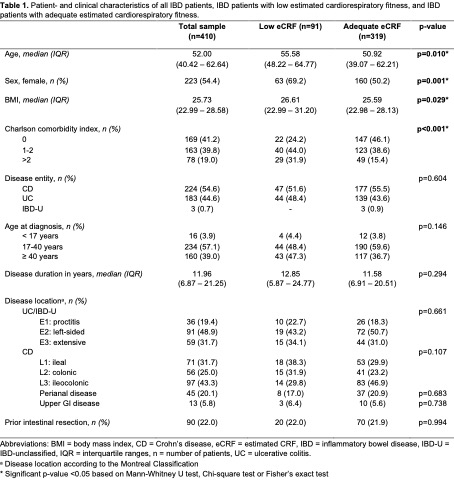P211 Factors associated with estimated cardiorespiratory fitness in patients with Inflammatory Bowel Disease: an exploratory analysis of real-world data
Demers, K.(1,2,3)*;Rezazadeh Ardabili , A.(2,3);Bongers, B.C.(2,4);Romberg-Camps , M.J.L.(5);van Bodegraven, A.A.(5);Jonkers , D.M.A.E.(2);Pierik, M.J.(2,3);Stassen, L.P.S.(1,2);
(1)Maastricht University Medical Center+, Department of Surgery, Maastricht, The Netherlands;(2)Maastricht University, School for Nutrition and Translational Research in Metabolism NUTRIM, Maastricht, The Netherlands;(3)Maastricht University Medical Center+, Division of Gastroenterology and Hepatology - Department of Internal Medicine, Maastricht, The Netherlands;(4)Maastricht University, Department of Epidemiology- Care and Public Health Research Institute CAPHRI, Maastricht, The Netherlands;(5)Zuyderland Medical Centre, Department of Gastroenterology- Geriatrics- Internal and Intensive Care Medicine Co-MIK, Heerlen-Sittard-Geleen, The Netherlands;
Background
Cardiorespiratory fitness (CRF) as a potential predictor of disease outcome in Inflammatory Bowel Disease (IBD) is understudied, as are risk factors for impaired CRF. Lifestyle interventions focusing on improving CRF may aid in enhancing subjective health, decreasing disability, or even controlling inflammation. The aim of this exploratory study was to investigate risk factors for low estimated CRF (eCRF), as well as the association between eCRF and patient-reported outcomes of IBD in a real-world cohort.
Methods
A cross-sectional multicenter study was performed between 26 Oct 2021 and 19 Oct 2022, enrolling IBD patients using the remote monitor platform myIBDcoach. Patients reported on disease activity, lifestyle factors, and psychosocial functioning. The four-question Modified Duke Activity Status Index (M-DASI-4Q) was used to assess eCRF, which is a simple screening tool for detecting the risk of impaired CRF as objectively measured with physical exercise tests. The number of positive responses to each of the four questions determines the final score, ranging from 0 to 4. To date, no accepted cut-off for (e)CRF has been identified for patients with IBD. Therefore, an M-DASI-4Q score below the 25th percentile of the study population was exploratively used to define low eCRF. Multivariable logistic regression analysis was performed to identify factors associated with eCRF.
Results
In total, 410 patients were included, of which 91 (22.2%) had low eCRF. The median M-DASI-4Q score was 3 (IQR 2-4). Low eCRF was characterized by higher age, female sex, higher BMI, and more comorbidities compared to patients with adequate eCRF (Table 1). Patients with low eCRF reported statistically significant higher levels of fatigue and stress, lower subjective disease control, and, remarkably, higher physical activity levels (Table 2). Multivariable logistic regression showed that female sex (adjusted Odds Ratio [aOR] 3.09), higher BMI (aOR 1.06), more comorbidities (aOR 3.77, aOR 8.52), fatigue (aOR 2.26), lower subjective disease control (aOR 0.90), and higher physical activity levels (aOR 2.29) were associated with low eCRF (Table 3).



Conclusion
In this exploratory study, we described an association between eCRF and patient- and clinical characteristics (sex, BMI, and comorbidities), as well as patient-reported outcomes of IBD (fatigue, and subjective disease control). Future research should investigate the validity of the M-DASI-4Q and determine thresholds for referral for further objective assessment for patients that might benefit from personalized interventions. Furthermore, future studies should further elucidate the interaction between physical activity and (e)CRF in patients with IBD to define recommendations.


